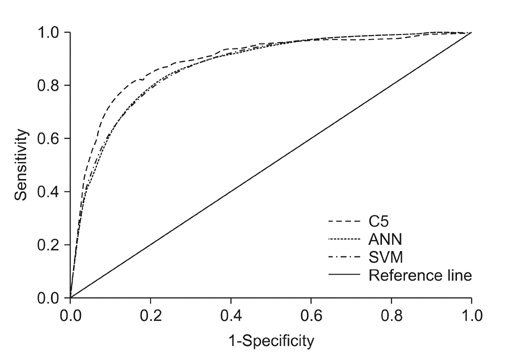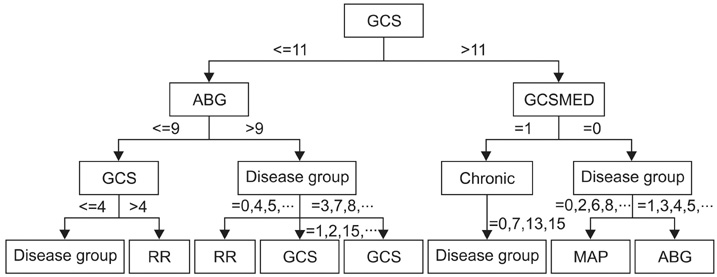A Comparison of Intensive Care Unit Mortality Prediction Models through the Use of Data Mining Techniques
- Affiliations
-
- 1College of Communication and Information Studies and Department of Pathology and Laboratory Medicine, University of Kentucky, Lexington, KY, USA. sujinkim@uky.edu
- 2Department of Biomedical Informatics, Ajou University School of Medicine, Suwon, Korea.
- KMID: 2284550
- DOI: http://doi.org/10.4258/hir.2011.17.4.232
Abstract
OBJECTIVES
The intensive care environment generates a wealth of critical care data suited to developing a well-calibrated prediction tool. This study was done to develop an intensive care unit (ICU) mortality prediction model built on University of Kentucky Hospital (UKH)'s data and to assess whether the performance of various data mining techniques, such as the artificial neural network (ANN), support vector machine (SVM) and decision trees (DT), outperform the conventional logistic regression (LR) statistical model.
METHODS
The models were built on ICU data collected regarding 38,474 admissions to the UKH between January 1998 and September 2007. The first 24 hours of the ICU admission data were used, including patient demographics, admission information, physiology data, chronic health items, and outcome information.
RESULTS
Only 15 study variables were identified as significant for inclusion in the model development. The DT algorithm slightly outperformed (AUC, 0.892) the other data mining techniques, followed by the ANN (AUC, 0.874), and SVM (AUC, 0.876), compared to that of the APACHE III performance (AUC, 0.871).
CONCLUSIONS
With fewer variables needed, the machine learning algorithms that we developed were proven to be as good as the conventional APACHE III prediction.
MeSH Terms
Figure
Cited by 4 articles
-
Real-Data Comparison of Data Mining Methods in Prediction of Diabetes in Iran
Lily Tapak, Hossein Mahjub, Omid Hamidi, Jalal Poorolajal
Healthc Inform Res. 2013;19(3):177-185. doi: 10.4258/hir.2013.19.3.177.Prediction Model for Health-Related Quality of Life of Elderly with Chronic Diseases using Machine Learning Techniques
Soo-Kyoung Lee, Youn-Jung Son, Jeongeun Kim, Hong-Gee Kim, Jae-Il Lee, Bo-Yeong Kang, Hyeon-Sung Cho, Sungin Lee
Healthc Inform Res. 2014;20(2):125-134. doi: 10.4258/hir.2014.20.2.125.Korean Anaphora Recognition System to Develop Healthcare Dialogue-Type Agent
Junggi Yang, Youngho Lee
Healthc Inform Res. 2014;20(4):272-279. doi: 10.4258/hir.2014.20.4.272.Machine Learning for Benchmarking Critical Care Outcomes
Louis Atallah, Mohsen Nabian, Ludmila Brochini, Pamela J. Amelung
Healthc Inform Res. 2023;29(4):301-314. doi: 10.4258/hir.2023.29.4.301.
Reference
-
1. Ramon J, Fierens D, Guiza F, Meyfroidt G, Blockeel H, Bruynooghe M, van den Berghe G. Mining data from intensive care patines. Adv Eng Inform. 2007. 21:243–256.2. Silva A, Cortez P, Santos MF, Gomes L, Neves J. Mortality assessment in intensive care units via adverse events using artificial neural networks. Artif Intell Med. 2006. 36:223–234.
Article3. Rosenberg AL. Recent innovations in intensive care unit risk-prediction models. Curr Opin Crit Care. 2002. 8:321–330.
Article4. Knaus WA. APACHE 1978-2001: the development of a quality assurance system based on prognosis: milestones and personal reflections. Arch Surg. 2002. 137:37–41.5. Knaus WA, Wagner DP, Draper EA, Zimmerman JE, Bergner M, Bastos PG, Sirio CA, Murphy DJ, Lotring T, Damiano A. The APACHE III prognostic system. Risk prediction of hospital mortality for critically ill hospitalized adults. Chest. 1991. 100:1619–1636.6. Le Gall JR, Loirat P, Alperovitch A, Glaser P, Granthil C, Mathieu D, Mercier P, Thomas R, Villers D. A simplified acute physiology score for ICU patients. Crit Care Med. 1984. 12:975–977.
Article7. Le Gall JR, Lemeshow S, Saulnier F. A new Simplified Acute Physiology Score (SAPS II) based on a European/North American multicenter study. JAMA. 1993. 270:2957–2963.
Article8. Morik K, Imhoff M, Brockhausen P, Joachims T, Gather U. Knowledge discovery and knowledge validation in intensive care. Artif Intell Med. 2000. 19:225–249.
Article9. Moser SA, Jones WT, Brossette SE. Application of data mining to intensive care unit microbiologic data. Emerg Infect Dis. 1999. 5:454–457.10. Ganzert S, Guttmann J, Kersting K, Kuhlen R, Putensen C, Sydow M, Kramer S. Analysis of respiratory pressure-volume curves in intensive care medicine using inductive machine learning. Artif Intell Med. 2002. 26:69–86.
Article11. Lucas P. Bayesian analysis, pattern analysis, and data mining in health care. Curr Opin Crit Care. 2004. 10:399–403.
Article12. Kreke JE, Schaefer AJ, Roberts MS. Simulation and critical care modeling. Curr Opin Crit Care. 2004. 10:395–398.
Article13. Kong L, Milbrandt EB, Weissfeld LA. Advances in statistical methodology and their application in critical care. Curr Opin Crit Care. 2004. 10:391–394.
Article14. Sierra B, Serrano N, Larranaga P, Plasencia EJ, Inza I, Jiménez JJ, Revuelta P, Mora ML. Using Bayesian networks in the construction of a bi-level multi-classifier. A case study using intensive care unit patients data. Artif Intell Med. 2001. 22:233–248.
Article15. APACHE Medical Systems Inc. APACHE III methodology training critical care. 1998. McLean, VA: APACHE Medical Systems Inc..16. The APACHE IV equations: benchmarks for mortality and resource use [Internet]. Cerner Corporation. c2011. cited at 2011 Dec 1. Cerner Corporation;Available from http://www.cerner.com/public/Cerner_3.asp?id=27300.17. SPSS Inc. Clementine help manual ver. 10.1. 2005. Chicago, IL: SPSS Inc..18. Green M, Bjork J, Forberg J, Ekelund U, Edenbrandt L, Ohlsson M. Comparison between neural networks and multiple logistic regression to predict acute coronary syndrome in the emergency room. Artif Intell Med. 2006. 38:305–318.
Article19. Lemeshow S, Hosmer DW Jr. A review of goodness of fit statistics for use in the development of logistic regression models. Am J Epidemiol. 1982. 115:92–106.
Article20. Lemeshow S, Teres D, Klar J, Avrunin JS, Gehlbach SH, Rapoport J. Mortality Probability Models (MPM II) based on an international cohort of intensive care unit patients. JAMA. 1993. 270:2478–2486.
Article21. Lemeshow S, Le Gall JR. Modeling the severity of illness of ICU patients. A systems update. JAMA. 1994. 272:1049–1055.
Article22. Delen D, Walker G, Kadam A. Predicting breast cancer survivability: a comparison of three data mining methods. Artif Intell Med. 2005. 34:113–127.
Article23. Crawford ED, Batuello JT, Snow P, Gamito EJ, McLeod DG, Partin AW, Stone N, Montie J, Stock R, Lynch J, Brandt J. The use of artificial intelligence technology to predict lymph node spread in men with clinically localized prostate carcinoma. Cancer. 2000. 88:2105–2109.
Article24. Terrin N, Schmid CH, Griffith JL, D'Agostino RB, Selker HP. External validity of predictive models: a comparison of logistic regression, classification trees, and neural networks. J Clin Epidemiol. 2003. 56:721–729.
Article25. Wong LS, Young JD. A comparison of ICU mortality prediction using the APACHE II scoring system and artificial neural networks. Anaesthesia. 1999. 54:1048–1054.
Article26. Jacobs S, Chang RW, Lee B, Lee B. Audit of intensive care: a 30 month experience using the Apache II severity of disease classification system. Intensive Care Med. 1988. 14:567–574.
Article27. Frize M, Ennett CM, Stevenson M, Trigg HC. Clinical decision support systems for intensive care units: using artificial neural networks. Med Eng Phys. 2001. 23:217–225.
Article28. Clermont G, Angus DC, DiRusso SM, Griffin M, Linde-Zwirble WT. Predicting hospital mortality for patients in the intensive care unit: a comparison of artificial neural networks with logistic regression models. Crit Care Med. 2001. 29:291–296.
Article29. Harrison RF, Kennedy RL. Artificial neural network models for prediction of acute coronary syndromes using clinical data from the time of presentation. Ann Emerg Med. 2005. 46:431–439.
Article30. Nimgaonkar A, Karnad DR, Sudarshan S, Ohno-Machado L, Kohane I. Prediction of mortality in an Indian intensive care unit. Comparison between APACHE II and artificial neural networks. Intensive Care Med. 2004. 30:248–253.
Article31. Jaimes F, Farbiarz J, Alvarez D, Martinez C. Comparison between logistic regression and neural networks to predict death in patients with suspected sepsis in the emergency room. Crit Care. 2005. 9:R150–R156.
- Full Text Links
- Actions
-
Cited
- CITED
-
- Close
- Share
- Similar articles
-
- Comparison of Hospital Charge Prediction Models for Colorectal Cancer Patients: Neural Network vs. Decision Tree Models
- Interhospital Comparison of Outcome from Intensive Care Unit with APACHE III Scoring System
- Validation of the APACHE IV model and its comparison with the APACHE II, SAPS 3, and Korean SAPS 3 models for the prediction of hospital mortality in a Korean surgical intensive care unit
- Data Mining Application for Knowledge Management in Medical Field
- Evaluation of the Clinical Effect of Intravenous Glutamine on Intensive Care Unit Patients



